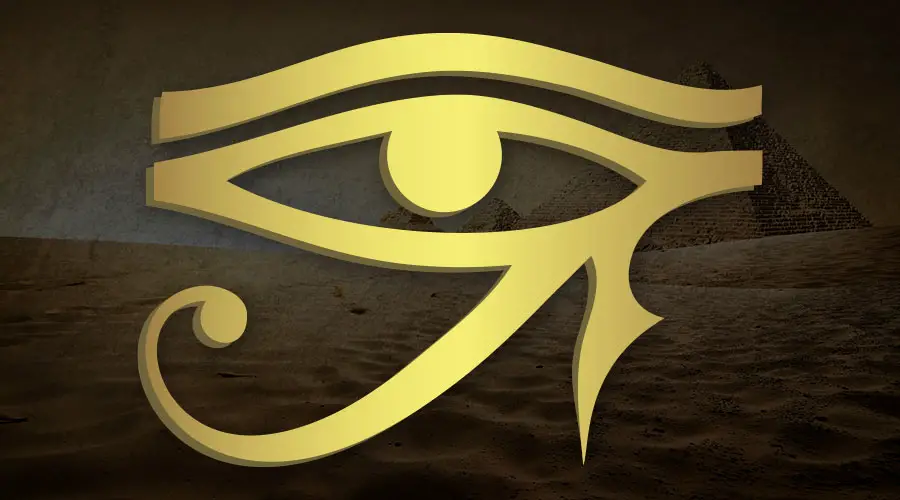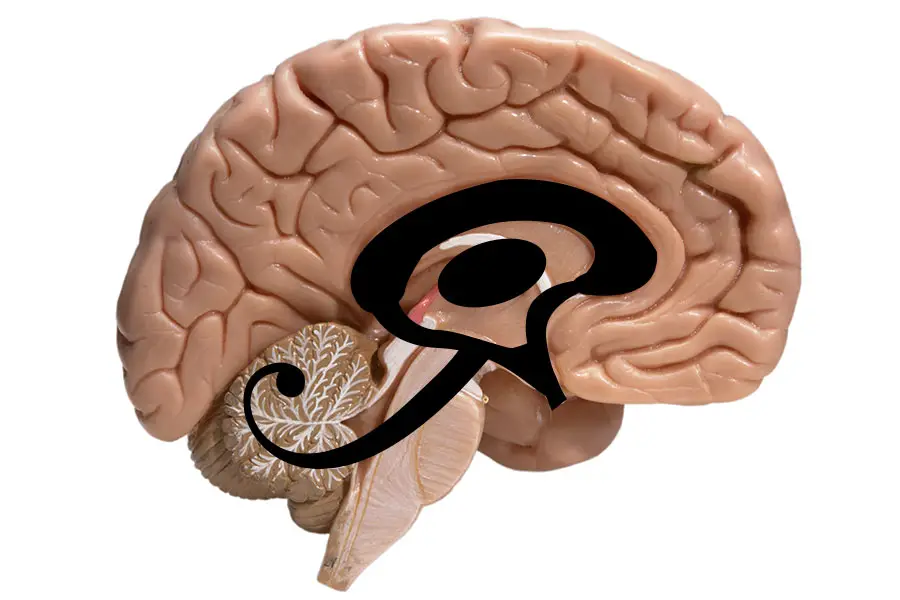When we see the Eye of Horus symbol, we intuitively know that is a symbol very rich in meaning and significance. It comes from ancient Egyptian mythology, and bears incredible resemblance to parts of the human brain.
The Eye of Horus symbolizes protection, health, sacrifice, light and restoration. It originates in the myth of Seth gauging Horus’s eye during their struggle for the throne of Egypt. The symbol resembles the anatomical parts of the human brain involved in our senses.
The struggle between Horus and Seth is one of the most important myths in ancient Egyptian mythology, and is important to understand if you want to have a deep knowledge of the esoteric. Also, the Eye of Horus reveals the incredible knowledge the Egyptians had of the human brain.

Horus the Egyptian God of the Sky
To the ancient Egyptians, Horus was considered the god of the sky. He was the son of Osiris and Isis, and had the head of a falcon. His right eye was the sun or morning star, representing power and his left eye the moon, or evening star representing healing. He eventually became the ruler of Egypt, and therefor also represents kingship. To the ancient Egyptians, their king was considered the manifestation of Horus.
Seth and the Eye of Horus
One of the most important myths, often called “the Osiris Myth” involves Horus, his father Osiris, and his uncle Seth. Osiris was the king of Egypt until his younger brother Seth murdered him, in an attempt to claim the throne. The rightful heir after Osiris was his son Horus, and Seth and Horus became enemies.
When Seth murdered Osiris, he cut the body into fourteen pieces. He did this so that Osiris could not properly journey to the afterlife, since it was necessary for the deceased to be properly embalmed and buried in a royal tomb in order for it to journey to the underworld for judgement.
Horus and Isis, who is the wife of Osiris and mother of Horus, were able to recover thirteen of the fourteen body parts. Osiris then went on to become the god of the underworld.
At this point in the story Horus and Seth are engaged in a struggle for the kingdom of Egypt and start fighting. In the fight, Seth gauges out Horus’s left eye (the moon) and smashes it into six pieces. The pieces get collected by the god Thoth, who puts them back together and delivers the restored eye to Horus. This is a big part of why the Eye of Horus symbolizes restoration.
There are different versions, some say Hathor, the cohort of Horus, was the one that put the eye back together.
Instead of using the eye like he did before, Horus puts it on the forehead of his father Osiris, which woke up a new consciousness and brought light to the underworld.
From this legend of the hieroglyph of the eye of Horus was developed. Horus goes on to kill Seth, claim the throne, and restore order to Egypt. Later in Egypt, the Kings and Pharaohs were considered to be representatives of Horus on earth.
The Eye of Horus and the Human Brain
The symbol of the Eye of Horus comes from the mythology of the struggle between Horus and Seth, but there is also a profound anatomical element to it. The symbol bears undeniable resemblance to certain anatomical features of the human brain, proving the Egyptians had advanced knowledge of the subject. In fact, they even developed special instruments and techniques for performing surgery.
When you overlay the Eye of Horus on the human brain, something remarkable happens, as the shape of the symbol corresponds with parts of the brain that are involved in our senses.
- The right side of the eye is smell
- The pupil is sight
- The eyebrow is thought and wisdom
- The left side of the eye is hearing
- The curved tail is taste
- The teardrop is touch

The Pineal Gland and the Eye of Horus
The Eye of Horus is also a reference to the pineal gland, which sits near the center of the brain. It is associated with psychic experiences, intuition, and the 6th chakra, also known as the third eye. The pharaohs would wear symbols on their headdresses to represent the third eye. You can read more about the third eye chakra here.
Despite being located inside the brain, the pineal gland has a very unusual feature, in that it contains light sensitive cells. The hypothalamus directs the light from our eyesight to various parts of the brain, including the pineal gland. When the pineal gland receives more light, it produces more melatonin, which regulates our sleeping patterns and dream phases.
The pineal gland releases DMT shortly before the moment of death. DMT effects the visual cortex of the brain, and plays a large role in near death experiences. DMT is found in ayahuasca, the plant medicine used by shamans in Latin America. When consuming ayahuasca, a person can enter a sort of trance state in which they catch glimpses of the afterlife.
The Feather of Maat and the Scales of Truth
In ancient Egypt the initiates had to go through a similar experience of catching glimpses of the afterlife. It was believed that through death the souls was able to go to a higher world. At the moment of death the soul was released from the body and taken to the underworld by Anubis. The heart of the deceased was weighed on the Scales of Truth against the feathers of Maat. If the judgement was positive, the soul was reunited with the body and ferried in the sun boat of Ra to the higher world. If the heart had negative karma, the soul would be reborn in a new body.

The Eye of Horus Mystery Schools
It is worth noting that in ancient Egypt there were three mystery schools named after the Eye of Horus. There was the Left Eye of Horus, who practiced the feminine path. There was also the Right Eye of Horus mystery school, who practiced the masculine path. And there was the Little Eye of Horus who were the child path.
The Use of the Eye of Horus Symbol in Egypt
The symbol has been found on stone carvings throughout many different eras in ancient Egypt. Pairs of Horus eyes were often painted on coffins, as well as on the bows of boats. In particular, the symbol was used on amulets, small pieces of jewelry that are worn for protection. Conventional Egyptologists have found evidence of these ranging from the late Old Kingdom (2700 BC – 2200 BC) to Roman times. Egyptians were usually buried wearing an amulet, and mummies have been discovered displaying this. Even ancient Egyptian mummies with tattoos of the Eye of Horus have been discovered.

The Eye of Horus Hieroglyph and Egyptian Mathematics
Another dimension to the meaning of the Eye of Horus is that some believe it contains information about how the Egyptians worked with fractions in their system of math. The Egyptians used a measurement called a “cubit” to measure length, and a “hekat” to measure volume, and that Eye of Horus in hieroglyphic form was used to represent different fractions. The theories goes like this:
- 1/2: the inner corner of the eye
- 1/4: the pupil
- 1/8: the eyebrow
- 1/16: the outer corner
- 1/32: the curling line
- 1/64: the cheek mark
The system of writing fractions is profound, because in the Osiris myth, the Eye of Horus was broken in fractions before being made whole again. When you add up the fractions, it is missing 1/64, which is believed the be the magical part that Thoth used when he restored the eye. The missing 1/64 is also a reference to the pineal gland.
Recommended Reading
If you want to continue exploring this subject more deeply, you can see which books I recommend by clicking here.

